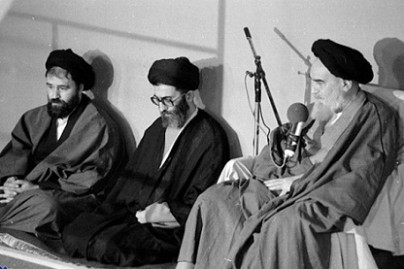A summary of Ayatollah Khamanei’s 8 years of jihadi management as president
The eight years of Ayatollah Ali Khamenei’s presidency was a period for the management of the war and economic isolation along with the important process of building and shaping organizations for the Islamic Republic

Navideshahed:
He had on agenda the tasks of making and coordinating organizations under the shadow of war and a fight against anti-revolutionaries and the Monafeqin and liberals at a time when in the foreign relations sphere there was a need to introduce the Revolution and the positions of the country in the face of measures taken against Iran by enemies.Publish Date : 12:36 - 2015 October 13
The eight years of Ayatollah Ali Khamenei’s presidency was a period for the management of the war and economic isolation along with the important process of building and shaping organizations for the Islamic Republic. He had on agenda the tasks of making and coordinating organizations under the shadow of war and a fight against anti-revolutionaries and the Monafeqin and liberals at a time when in the foreign relations sphere there was a need to introduce the Revolution and the positions of the country in the face of measures taken against Iran by enemies.
The Islamic Revolution Document Center has made a review of the measures accomplished by Ayatollah Khamenei as the president of Iran on the occasion of the anniversary of his swear-in.
After Mohammad Ali Rajaei was killed as the second president of the Islamic Republic of Iran, the central council of the Islamic Republic party as well as the Society of the Qom Seminary Teachers unanimously introduced ayatollah Khamenei as presidential candidate despite his own dissatisfaction. Imam Khomeini two okayed his candidacy despite the fact that he had initially been against clerics taking the post of presidency.
In the Iranian year 1360 elections were held and ayatollah Khamenei won 95 percent of the votes. He was sworn in 11 days later.
Ayatollah Khamenei came to office at a time when the fledgling government had not grown into a well-shaped being and there were no workgroups behind the president to help him with his tasks. Ayatollah Khamenei first of all started to reshape the presidential staff and started his job with a number of advisors.
With all the problems at that time, Ayatollah Khamenei’s agenda was as follows:
· To fully attend to the affairs of the war
· Starting economic policies directed at rearing the underprivileged and those in remote areas of the country
· Removing the aspects of the previous regime from all spheres of the lives of Iranians
· Discovering and tapping domestic talents in all areas and professions
· Providing social, bureaucratic, and judicial immunity aimed at better serving people
· Establishing safety and freedom for all people that were faithful to the Islamic Republic, whatever mode of thought they may entertain
Despite all the trouble that the war had created and the fact that the Islamic Republic was in the beginning years of its life, top on Ayatollah Khamenei’s agenda was attendance to people’s economy and culture.
After his first term as president, Ayatollah Khamenei did not desire to run for another term, seeing the troubles and disagreements with some members of the cabinet. But as Imam Khomeini obliged him to become candidate as part of his religious duty, he agreed to run for presidency and once again was elected with majority vote.
The points on his agenda during the second term were:
· Drafting a bill on the president’s privileges
· Reducing the government’s involvement and relegating affairs to people
· Appointing suitable, revolutionary, and effective officials
· Eradicating chronic poverty that prevailed the lives of people
· Giving farmlands to people and governmental industries to cooperatives
· Giving workers shares of their companies, improving nonoil export, and reducing the economy’s reliance on oil revenues
· Promoting people’s participation in economic and cultural affairs of the country as presided by the government
· Steering the country’s cultural policy toward cultural independence
Ayatollah Khamenei’s political and cultural activities
The notion of culture and fighting non-Islamic culture has been among the prominent policies of Ayatollah Khamenei. This is evidenced by his presidency over the Cultural Revolution staff and the Supreme Council on Cultural Revolution.
Intense pursuance of related issues was so that in the six first months of launching the council, 31 sessions were held where major policies were adopted on the country’s cultural affairs.
Reviving the Islamic Republic’s foreign policy
Another important area of Ayatollah Khamenei’s active policy was reshaping the Islamic Republic’s foreign policy. The most important points in this regard were:
· Adopting independent, well-adjusted policy in regard to each country and decision making in respect for the country’s expediency spiced with decisiveness and clarity
· Independence from the West and East
· Paying attention to Muslim unity
· Attempt in redeeming the rights of the Muslims of the world against world powers as well as fighting all moves to pave the way for superpowers to find a way to overrule the region
· Full attendance to the issue of Quds and other occupied lands of Palestine and full preparedness to fight the Zionist regime
· A return to the rich, novel Islamic culture in the international arena as a barrier against enemies
· Boosting Iran’s presence in international arenas
source: irdc.ir
Your Comment